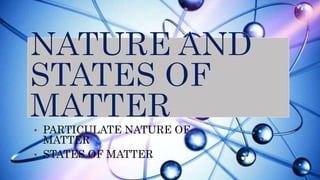
A.1 Nature and States of Matter.pptx
- 1. • PARTICULATE NATURE OF MATTER • STATES OF MATTER
- 2. Recognize that substances are made up of smaller particles
- 3. The earliest belief of Greek philosophers was that matter was made up of a single element.
- 4. Anaximenes (545 BCE) -Asserted that the primal element that makes up a matter was air. Thales of Miletus (6th Century BCE) -Thought it was air. Heraclitus (540-480 BCE) -Believed it was fire. Empedocles (490-430 BCE) -Later proposed that all matter is made up of four fundamental elements namely; Earth, Air, Fire and Water
- 5. The varying proportions of these element in different materials supposedly rendered the different characteristics and behavior of the materials. For instance, a stone was thought to contain mostly of earth, while a rabbit was believed to contain large proportion of water and fire which makes it soft and gives it life.
- 6. The problem with this idea, however, stemmed from the fact that when materials are broken down, they never resemble the fundamental elements Empedocles proposed. Because of this, an important concept was introduced now known as the Law of Constant Proportions which states that… all things of the same type have the same proportions of the elements that compose them.
- 7. Leucippus (440 BCE) and his student Democritus (460-370 BCE) -Wondered what would happen to a piece of gold if it is cut unevenly. The two philosophers concluded that there must be a smallest unit of gold that cannot be broken down without it ceasing to be gold. They called this unit Atomos, meaning ‘uncuttable’. The main theory of Leucippus and Democritus’ theory include the following: All matter is made up of atoms that are too tiny to be seen by the naked eyes. They cannot b broken down further into smaller portions. All forms of matter result from the coming together or breaking apart of atoms. Atoms are in constant motion around an empty space called void. Atoms are completely solid Atoms are uniform, with no internal structure. Atoms come in different shapes and sizes.
- 8. Epicurus of Samos (341-270 BCE) -popularized atomism, the philosophy that matter is made up of atoms. He further enhanced the theory by proposing different types of atoms have different weights, and that all atoms have the same speed regardless of size. Unfortunately, this philosophy was highly opposed by the more historically famous philosophers including Plato and Aristotle.
- 9. Aristotle agreed with Empedocles that all matter was made up of four fundamental elements in varying proportions. He also suggested that all elements could be transformed to another-a pioneering idea to the field of alchemy. Aristotle also added the fifth element Aether, which supposedly made up matter found outside of earth and the moon. Aristotle’s theory was recognized as a Continuous Theory, which asserted that matter can be divided indefinitely without changing the fundamental characteristics of the material-a direct contrast to the Discrete Theory of the
- 10. Matter is anything that has mass and volume. Mass is the amount of matter, while volume is the space it occupies.
- 11. 3 Main states of matter 1. Solid 2. Liquid 3. Gas 4. Plasma 5. Bose-Einstein Condensate
- 12. Have definite shape and volume. The particles in a solid are tightly packed together, thus, solids are almost incompressible. The particles vibrate in a fixed position; they cannot move around or slide past each other. Solids have high densities and can expand only slightly when heated.
- 13. A liquid has no definite shape but has a definite volume. The particles in a liquid are close with one another, but not as close as those in a solid. The particles are not arranged in a rigid or orderly manner; they can slide past each other, allowing the liquid to flow freely and take shape in a container in which it is placed. Liquids are almost incompressible, but they tend to expand slightly when heated. They generally have medium densities.
- 14. Gases take the shape of their container. However, they have no definite volume. A gas can expand to fill any volume, thus it takes both the shape and volume of its container. The particles in a gas are usually much farther apart than those in a liquid. Because of the large spaces between the particles, gases are easily compressed into smaller volume when pressure is increased, but they greatly expand when heated. Gases also have low densities.
- 15. Plasma is the fourth state of matter. Formed by heating and ionizing a gas, plasmas are made up of groups of negatively and positively charged particles. Plasmas are not the same as gases; they have neither a definite volume nor a definite shape. They are often observed in ionized gases, aurora borealis, lightning, and comet tails.
- 16. Sir William Crookes is a British Chemist and physicist who discovered the element thallium in 1861. he was on of the scientists to discover plasma, and in 1879, identified it as the fourth state of matter. Crookes also developed the Crookes tube and the Spinthariscope-instruments used to study cathode rays (streams of electrons) and nuclear reactivity, respectively.
- 17. Produced when a cloud of bosons (type of elementary particle of matter) is cooled to temperatures very close to absolute zero (T=0K) such that a large fraction of the bosons condense. Bose-Einstein condensates include superfluids like cold liquid helium, and superconductors like the nucleons inside a neutron star.
- 18. Seatwork #1 1. Describe the arrangement and behavior of particles of the following substances: Air Alcohol bottle